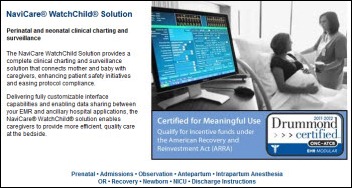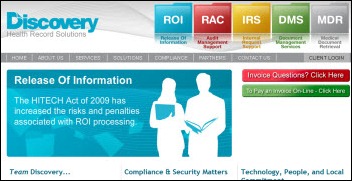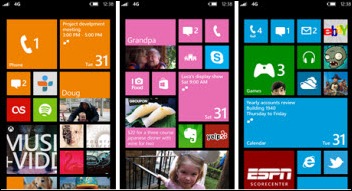Anything related to defense will need to go to Genesis.
Monday Morning Update 6/25/12
From DCollins: “Re: WatchChild. Rumored to be up for sale. That would be a huge signal to the world of HIT – why divest in times of growth?” Unverified, but even if it’s true, I don’t know if I would draw too many negative inferences about the healthcare IT market as a whole. The WatchChild OB monitoring system is owned by Hill-Rom, mostly known for selling expensive hospital beds and a few other marginally related product lines. WatchChild was supposed to be a natural extension of the company’s NaviCare nurse call system. HRC shares haven’t exactly shone lately, dropping from $48 in July 2011 to $30 now, so Hill-Rom may simply see the frenzy of M&A activity in healthcare IT as a good opportunity to sell some or all of its IT holdings to focus on core business. All of this is speculation since they’ve made no announcement that I’ve seen. Hill-Rom used to be known as Hillenbrand Industries, whose humorously complementary business was Batesville Casket Company. I’ve always wondered if they might put some of their nurse call technology in those caskets as an upgrade for those who fear being buried alive.
From TopExecIT: “Re: MRO. Overheard that it has acquired smaller release-of-information vendor Discovery Health Record Solutions.” Unverified.
From Grammar Neighborhood Watch: “Re: grammar mistakes. Thought you would enjoy this WSJ article called This Embarrasses You and I.” You are correct – I did enjoy the article, which calls out the “epidemic of grammar gaffes in the workplace” as the grammatically challenged get even sloppier as encouraged by Twitter and similar stream-of-consciousness outlets for narcissism (especially the younger folks, taught by questionable educational methods to ignore long-standing rules suggesting that maybe it’s a good idea to spell words correctly and compose sentences that the rest of us can easily follow, for the same reason that traffic laws encourage societal harmony.) Worse yet is that people actually get snippy if anyone points out their mistakes, as though being careful about language is a character flaw. The article suggests that companies have become sloppy in allowing poorly constructed writing to be blasted out publicly. It brings up an issue that is one of few that I would defend physically if necessary: the Oxford comma, omission of which is indefensibly illogical. I nearly always have to fix that when folks send items to run on HIStalk. The other is equally illogical and indefensible — sticking two spaces after every period. Unless you’re writing on a typewriter that supports only monospace fonts and thus requires the extra space to provide a visual break, placing two spaces after a period is just plain wrong.
From Kermit Randa: “Re: question about Epic and FDA regulation of transfusion systems. I think the question warrants a broader discussion around software as a regulated medical device. The FDA has classified numerous specific products that perform data and information transfer, storage, display, conversion, and similar management functions, such as a LIS or PACS. Last year, the FDA raised more questions than it resolved when it issued a new classification, the Medical Device Data System (MDDS) which it defines as hardware or software products that transfer, store, convert formats, and display medical device data. The FDA, in its commentary, made clear the definition of an MDDS is narrow. For example, an MDDS does not modify the data or modify the display of the data, does not by itself control the functions or parameters of any other medical device, and is not intended to be used for active patient monitoring. However, the FDA was not clear about whether or how they would classify software that falls on the outside edges of the MDDS definition and does not fall under one of the earlier classifications such as LIS or PACS. Furthermore, the FDA made clear that a health care facility may be directly responsible for compliance with the FDA regs for an MDDS, not just its software vendors. So as we all work to streamline clinical workflows and achieve meaningful use, the intersection between different types of information systems is raising issues about medical device compliance. More here, or click here to see which companies have registered as a manufacture of an MDDS (enter OUG in the product code search field.)” Thanks to Kermit, a long-time reader and COO of Surgical Information Systems, for providing that explanation. It seems that the climate for FDA regulation of some aspects of healthcare IT is heating up, so it’s worth watching carefully.
From Privacy Shrink: “Re: sharing patient data in Boston. I like the comparison between mental illness and Parkinson’s disease.” The article describes how Boston area hospitals handle sensitive parts of the medical record, such as psychiatric notes. Partners HealthCare says every doctor needs to see everything, so patients must request that certain information be placed off limits and Partners makes the final call. BIDMC allows psychiatrists to restrict access to the information they create. Neither system described any capability for patients to become involved in the decision. Privacy is a tough issue, but I’m siding with the patient – why can’t I decide who sees my information? The Partners approach comes across as smug and paternalistic, with the patient serving as a low-ranking, inherently unreliable player apt to gum up the disease mitigation factory works.
From The PACS Designer: “Re: Microsoft’s Phone 8. Along with the upcoming Microsoft Windows 8 release this fall, we’ll also get Windows Phone 8. It appears that Microsoft wants a piece of the enterprise business for phone improvements and has structured Phone 8 as an alternative to Bring Your Own Device (BYOD) to give IT total control of phone security enforcement within institutional walls.” Good luck with that. Microsoft’s consumer strategy seems to be to imitate whatever Apple is doing, adding in its usual missteps, poor design, and uninspired marketing. The result is predictable. There was a time when Microsoft was a near-religion among geeks and businesspeople who dismissed Apple as a bunch of hippies building products used mostly by students and temperamental artistes, but even those former Gates fanboys now worship at the Cupertino altar.
The feds should make doctors and hospitals jump through only evidence-based hoops, 93% of respondents said. New poll to your right: are hospitals and practices applying good financial analysis and ROI calculations to make EMR purchasing decisions? Obviously your yes/no vote makes you one of the silent majority or minority, but you can overcome the “silent” part by adding a comment by just clicking the comments link right below the survey’s voting button.
A hospital in Northern Ireland finds that a problem with its radiology information system caused radiologists to miss reading 17,000 images over several years. They’re reading the images now and have set up a patient hotline.
Nominations are open for HIMSS board and nominating committee positions. I know several folks who have used their HIMSS positions as a nice career springboard, so that might be the additional carrot you need to throw your hat in the ring if you have something to offer HIMSS beyond unbridled ambition.
HealthCor, the Allscripts shareholder that threatened a proxy fight until the company gave it three board seats, raises its ownership of the company from 6.1% to 7.3%. Share price has been flat since it fell off a cliff in late April following several negative announcements. The hugely important next quarterly report is scheduled for August.
HIM/IT services and outsourcing provider Anthelio (the artist formerly known as PHNS) names John Dragovits as president and COO. He was formerly EVP/CFO of Parkland Memorial Hospital and was a Cerner VP before that.
Nordic Consulting, a Madison-based, Epic-only consulting firm, is ranked #1 in staffing and implementation support in “Navigating the Sea of Epic Consulting,” a new KLAS report.
In England, several NHS trusts join together to seek a replacement for their RiO mental health EMR, expecting spend up to $470 million.
Vince has more to say about Dairyland and several related companies this week. You can help him out by reminding him of other companies he can riff about, especially if you were around in the early days prior to 1980 or so. I offer Continental Medical Systems, Megasource, Dynamic Healthcare Technology, Atwork, and Visteon/Avio as a few old-time names I’ve heard recently. In another angle of attack, has Vince missed any big personalities of that era, folks who kept turning up in one company after another? He would appreciate your ideas and contact information for the pioneers he could reminisce with.
Aetna and Inova Health System (VA) jointly form Innovation Health Plans, which will offer new HMO and PPO services. Inova’s healthcare services delivery will be supported by Aetna’s benefits administration and technology (presumably Medicity) that will allow physicians to track patient care.
London-based SwiftKey releases its on-screen tablet or phone keyboard for healthcare that claims to reduce text input time by 49% by predicting the next word to be typed. Price for this version wasn’t given since I suspect they’ll sell through hospitals and software vendors, but their non-healthcare product is $1.99, and priced appropriately given mixed reviews. Watching the guy thumbing his way through entering medical text in the video above made me nervous – doctors don’t pay enough attention to on-screen defaults and choices as it is, so I can envision some major medical errors caused by too-quick approval of the wrong word.
More Accretive Health fallout: the Treasury Department proposes regulations that would require charitable hospitals to keep their collection dogs on a leash, improving their effort to help patients qualify for financial assistance before garnishing their wages or dinging their credit scores.
An FDA report finds that software problems cause 24% of medical device recalls, also noting that the engineering teams that build medical devices are often woefully ignorant of best practices for developing and distributing software. It mentions FDA’s Functional Performance and Device Use Laboratory, which will allow the agency to test user interfaces and analyze device usability.








Northern Island?
[From Mr. H] Well done! I have corrected. Sometimes spell check with autocorrect on is your friend, sometimes your enemy!
It’s looking like it will take several (more) years to eradicate the mess caused by NPfIT and a lack of change management skills. IMHO, I can’t see any reason for companies to waste time and money making cases for NHS service change and modernisation strategies until NHS leadership (two words that perhaps don’t belong together) emerge from a cycle of ‘let’s just push some more mushy peas around on the plate’. Just a thought for Boards and CEOs – wait until there’s a real level of commitment to change, from the NHS, before wading into England’s post-NPfIT era of ‘let’s sit around and wait for a miracle to occur’.
http://www.ehi.co.uk/news/EHI/7850/nhs-on-a-'burning-financial-platform‘
Grammar Neighborhood Watch – give us “old” folks a break. it was drilled into us from our first typing class to put two spaces after a sentence and 40 years of muscle memory is hard to break! Besides, who decided it was wrong and why???? Toleration is good. 🙂
If NHS is on a “burning financial platform” … and US healthcare costs roughly twice as much per capita as British healthcare (with comparable or lower quality and not covering ~50 million people), then what situation are we in?
Other than bankrupting our country, of course…
Kermit is correct. “I think the question warrants a broader discussion around software as a regulated medical device.”
This is especially so since as you state later in this blog, software problems are the reason for 24% of the FDA recalls of medical devices.
Regarding ROI for EMRs. I can’t imagine going to the board and just asking for $500 million on intuition, so I can’t imagine they just flat out don’t do an ROI or NPV but I think they’re just following the lead of most of corporate America that either also doesn’t do a proper investment analysis or monkeys the numbers to do the projects they want to do.
For a country that prides itself on individualism, we spend a lot of time telling our bosses exactly what they want to hear. If what someone gets from reading between the lines is go build me a model that says we need Epic, don’t be surprised when they do it.
Although I’m a big patient privacy person, I do think that every clinician treating a patient should have access to everything about that patient. Letting patients make the call, given that they have little or no clinical knowledge and wouldn’t know when limiting access to a particular data point would be dangerous, seems like a recipe for disaster. That would be unless the laws change and clinicians couldn’t even be sued in situations like that, which isn’t likely. The only exception would be psych records, particularly therapy records, which aren’t very likely to have clinical data needed for medical care, and probably carry extremely personal information as well. You’d still want to know any diagnoses and meds from them, though. If patients don’t trust a particular clinician enough to let them see their information, they should probably find a clinician that they do trust.
Oh, and the iPad saves us double spacers that can’t stop by allowing us to skip the period and still double space and wind up with the “right” spacing.
I was one of the few that said “No” – ONC does not need to provide EBM for their measures… I was not surprised a lot of people said yes, but I’d suggest there are two arguments that make “No” the meaningfuly correct answer 🙂
1. We are still new to this game – EBM takes years of research, and we can’t expect to get EBM which says “being able to define and track smokers” helps save lives. We do have EBM which says cutting smoking saves lives, and we know in general that greater transparancy of data helps with quality programs. So if we waited for EBM on the idea of following a metric, we’d never get anywhere.
2. This is less about any specific metric, and more about the importance of actually being able to measure and report on data. In other words, I think it is important for users to understand HOW to do this…and then let them innovate on what they will do to improve it at their organizations.
With all that said, I’d offer two suggestions to ONC:
1. Relax a bit on WHICH metrics are followed… give us a choice, more variety… because different ones are going to be important to different populations… again, focus on the fact that we are learning how to capture, measure and report on metrics – don’t feel you need to focus on EXACTLY which ones they are – we’ll figure out which ones work best for our situations.
2. Do think about getting vendors to either stick to a common data model (although that train has likely left the station), or at least requiring them all to agree to some standard API… why not make them all show they can write and accept APIs from the SMARTPlatform – that would be a cool way to encourage innovators to create new systems that can work more easily with all EMRs!
I’m officially throwing down the gauntlet and challenging Mr. HISTalk to an arm-wrestling match in an attempt to eradicate the Oxford comma once and for all ( or at least in the world of healthcare IT editorial). Perhaps my lack of love for the excessive mark of punctuation is due to my predilection for short bursts of communication, i.e. tweets.
Likely being of similar vintage to Dr. Parker, and thankful that I actually paid attention in typing class decades ago when there may have been little incentive for the average dude to do so, I never saw the style memo that announced the end of the double-space. Conversely, I thought it became scarce because today’s kids are mostly self-taught typists and the “style” with which typing was once taught has gone the way of the dinosaur.
re Grammar: What a marvelous way to start my week! I feel newly empowered by the knowledge that I am free to resume usage of the Oxford comma. My finger twitches yearningly toward the comma key on the keyboard, yet I have forborn use of that final comma since a Ph.D. co-worker ‘enlightened’ me use of the third comma was no longer correct and, worse, AGED me. Like wearing panty hose. So, as of today, I will boldy insert that noble squiggle. Panty hose? Absolutely not. Haven’t you heard that ages you?
Regarding grammar and proper sentence structure, Mr. HISTalk, you made a mistake in your response. A period should not go inside a parenthetical mark. It should read like this: ).
Purdue University has an excellent Online Writing Lab (OWL) for those looking for a reference guide. http://owl.english.purdue.edu/
The Oxford comma is largely a matter of preference. The AP, The Economist, and New York Times style guides do not use the serial comma – Oxford, S&W and Chicago Manual of Style do. Even the Oxford PR standard eschews the serial comma. I would suggest press releases, if anywhere, should omit the serial comma to conform to industry standards.
Even the US Government’s Printing office uses the serial comma. Mr. H, that must present a dilemma, given your assumption that everything the government does is wrong. 🙂
I don’t understand what there getting so upset about over their at the WSJ. They seem to have they’re knickers in a twist about grammar for no good reason.
The same ambiguity argument for the comma goes for the double spaced period. Two spaces after the period is how you distinguish between the end of the sentence, and the end of an abbreviation.
Logical and defensible.
From the l33t lan6wij p0l1c3.
OMG! Oxford comma YES. And I wouldn’t get caught dead talking about “you and I.” I’ll admit my double space after periods is a bit hard-wired. I’ll have to work on this.
+1 for the Oxford comma (a.k.a. serial comma). Pet peeve of mine, too.
Another vote for the Oxford comma (a.k.a. serial comma). Pet peeve of mine, too.
Two spaces after a period: as mentioned by Mr. H, this makes sense only with fixed-width (aka mono-spaced) fonts. There are various typographical conventions about this, but two spaces after a period is the result of the use of typewriters. It makes sense that with the disappearance of typewriters and the use of modern word processors and typesetting programs like TeX/LaTeX (which do use single, but enlarged space at the end of a sentence) there is no need for double space anymore.
http://en.wikipedia.org/wiki/Sentence_spacing
I thinkHill Rom sold the NaviCare product to Teletrackng
WatchChild was sunsetted last year and replaced by NaviCare WatchChild, which is now on a Windows platform (the original was on AIX with an Oracle database). And the problem with rumors is that they are exactly that: rumors. Everything is for sale…at the right price. If you want to have a conversation about what’s going on in the obstetric application world, you should include Obix (for sale), GE (now trying to get on the Epic bandwagon that Obix and NaviCare WatchChild are already on), and Philips. Those are the standalone products. Then there’s Cerner, who has tried to promote its own home-grown FetaLink and McKesson, who bought assets from LMS. And finally, PeriGen. In a market with maximum product saturation, you still have the need for surveillance, archiving and record keeping in the most litigious area of the hospital. And these records, including the fetal strip, must be stored for a minimum of 21 years in most states. Compare that to the EMR data. And this one is classified as a medical device by the FDA. It’s why the big boys stayed away from labor and delivery all those years. And I vote for non-use of the Oxford comma and for single space after a period. And don’t even get me started about “its”!